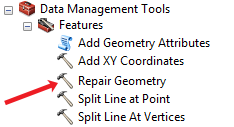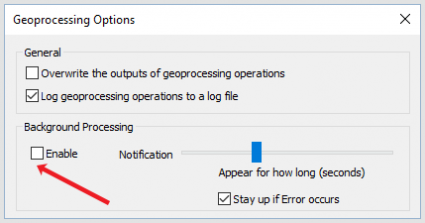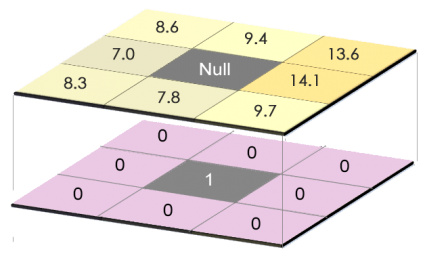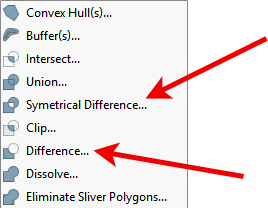Where Is The Repair Geometry Tool In Arcgis 10

How to Fix the Esri 999999 Error
Some things in life are certain. In ArcGIS, information technology'south the Esri 999999 error.
Basically, when ArcGIS can't specify what is causing an fault, it will shoot out this generic error.
AKA the error that gets yous all teary-eyed.
And then what's an ArcUser to do? Need assistance troubleshooting this mistake?
Here are some of the common ways to fix it.
1. Repair Your Geometry
A common culprit of the 999999 Esri error is minor geometry errors in your vector data. This is often composed of cipher geometry, short segments, and self-intersections.
When your log file reports a TopoEngine mistake, your all-time bet is to run the Repair Geometry tool. This tool inspects your features one-by-one applying relevant fixes repeating itself until your geometry is repaired.
If yous're working in a geodatabase, strangely you may have success by exporting your data to a shapefile. After exporting as a new shapefile, test out the tool again and see if information technology succeeds.

ii. Plow Off Background Processing
This is really the first affair everyone should do if you're having difficulties geoprocessing in ArcGIS. Although background processing can be useful to exercise two things at once, it'southward as well been known to mess upward your primary job – to geoprocess!
That's why your commencement step should be plough off background geoprocessing. You can practise this in the ArcGIS bill of fare under Geoprocessing > Geoprocessing Options.
From here, y'all'll have to uncheck the 'Enable' checkbox in the geoprocessing panel. Exam it out and it might just be your saving grace.

iii. Geoprocess in Chunks
When you're dealing with a massive raster filigree extents, information technology'southward often the case that you lot'll receive a 999999 fault. In order to prepare this, yous should employ the clip tool in carve up chunks. Later clipping your information, you lot tin loop through each filigree and procedure them separately.
But before starting out a looping procedure, you should pinpoint if this is the real trouble. Run a raster prune (information management) to test with a subset of your data if it'due south really the main offender. This has been more of a trouble in versions under 10.2.

4. Rewrite Your Output File Name
Avoid using special characters like dashes and spaces altogether in your output filename. Information technology's a bad addiction to start a feature class proper noun with a number, which can effect in a 999999 Esri mistake. Further to this, stay articulate of reserve words like GROUP, FOR, or Add together.
Another solution is to shorten your output file name. Rewrite your output file name as something shorter. If your data is in multiple subfolders, try shortening the path to a higher level directory such as C:\Data.

5. Swap Nothing Values to Nil
If yous're trying to perform raster math or create a pivot tabular array with null values, you're not going to take a good time.
Not even Excel likes Null values because it doesn't know how to handle them in a mathematical operation. When this isn't explicitly known for the processor, the relentless Esri 999999 mistake will pop upward.
Unbeknownst to the common user, the simple fix is to convert goose egg values to a zero. A good commencement is to use the IS NULL tool. For all Zip cells in a raster, it will output a value of one in an output raster.

6. Raster Problems
For those trying to run zonal statistics with a raster, this can exist a cumbersome fix often involving several workarounds. The get-go proffer is to convert your raster format. Instead of generating a raster in your default geodatabase, you should create a TIF.
There are bug working with decimals for zonal statistics. In this case, you will have to multiply your raster values past one hundred. After this, you can convert your raster to an integer using the int tool. From here, you can and then dissever your data by ane hundred to put it back in its original format. For this i, yous're going to have to wait more for the specific settings in that tool.

7. Delete Your Temp Folder
This one may be a bit of a reach, every bit this ane personally hasn't helped very much. But who knows, it may work for some. This Esri 999999 error occurs commonly with a log of "The tabular array already exists" or "File read/write mistake occurred".
If y'all've created a script and this fault occurs, it ways that the unfinished information may already exist in your temporary folder. The idea behind this is to delete your temporary data and re-run the process. Knowing that the file doesn't exist, the script can run uninterrupted.
Your temporary folder is located hither – C:\Users\yourname\AppData\Local\Temp
eight. Just Exercise It in QGIS
The reality is that most geoprocessing tools can be found in open up source software like QGIS. The powerful GIS software package known as QGIS has handfuls of tools that even includes the GRASS GIS framework.

Any of the problems listed to a higher place can be completed in QGIS searching through their massive selection of geo-algorithms.
And sometimes, information technology just makes sense to do the job correct in QGIS 3. Meanwhile, make sure to check out our article on 35 differences between ArcGIS Pro and QGIS 3.
Let's Put the 999999 Error to Balance
Depending on your information, the 999999 Esri fault tin can be a common occurrence.
If yous oasis't fixed your problem with this list, Esri provides excellent support with their user community forum Geonet.
Now, how almost that 999998 mistake?
Let us know with a annotate below.
Subscribe to our newsletter:
Source: https://gisgeography.com/esri-arcgis-999999-error/
Posted by: yatescoultan.blogspot.com


0 Response to "Where Is The Repair Geometry Tool In Arcgis 10"
Post a Comment